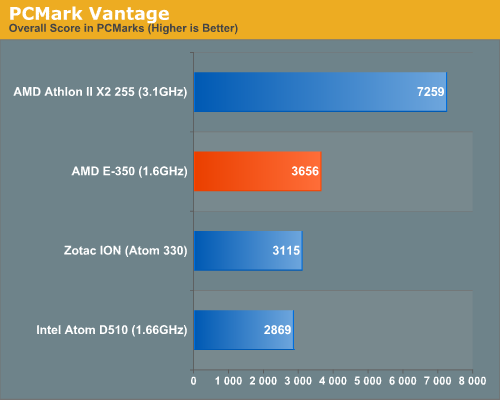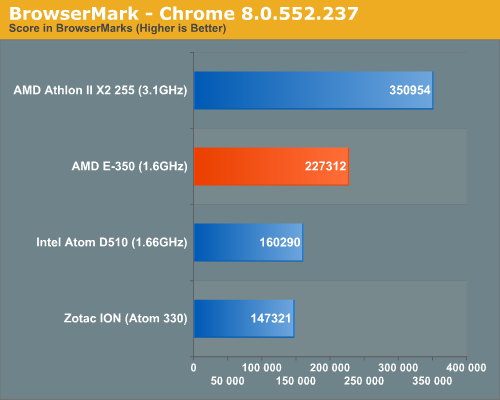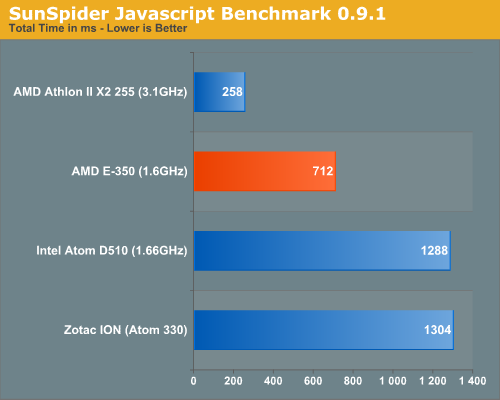The Brazos Review: AMD's E-350 Supplants ION for mini-ITX
by Anand Lal Shimpi on January 27, 2011 6:08 PM ESTGeneral Performance: In Between Atom and Athlon II
Atom may be efficient and fast enough to run a smartphone OS, but it absolutely chugs on Windows 7. The seat of the pants feel of an AMD E-350 is noticeably better. Single threaded performance, as you’ll soon see, is easily twice that of a similarly clocked Atom. Bobcat is still a dual-issue dual-core machine so high IPC or highly threaded workloads will show little difference between it and Atom. Thankfully, for most entry level netbook/nettop workloads Bobcat’s architecture should be sufficient. Before we get to the more CPU intensive tests I wanted to run through some reader requests for performance characterization.
I’ll start out with PCMark Vantage. There’s very little that separates PCMark from SYSMark in terms of how realistic the workload is. Neither suite is particularly representative of what an average user does today. What these suites are good at is being very long, and stressing enough aspects of a platform to give you a general idea of performance. SYSMark tends to focus on the more heavy user/content creation side of things (optimized for no more than 2 cores), while PCMark Vantage is much lighter test.
Looking at SYSMark you’d see no performance difference between the E-350 and Atom. The reason is simple. SYSMark was designed to be a modern day CPU benchmark. Most of the workloads exhibit high IPC and thus Bobcat’s front end acts as a bottleneck.
While SYSMark can be useful in estimating how a processor might handle particular heavy workload, it’s not useful in characterizing the sort of light workloads that you’d see a netbook or nettop user creating. PCMark Vantage is a collection of far simpler tasks. Again not specifically what you’d do today, but lighter nevertheless.
I compared four systems using PCMark Vantage, all with the same memory and I/O configuration. I dusted off an Atom 330 + ION motherboard from Zotac, an Atom D510, the MSI E-350 board and an Athlon II X2 255 on an 890GX motherboard. I picked the Athlon II simply because it’s a very affordable (~$65) modern day dual-core CPU. The Athlon II will help put the E-350’s performance compared to modern day x86 cores in perspective.

The E-350 holds a clear advantage over the Atom D510. The overall suite runs 27% faster on the E-350 than the D510, and even 17% faster than ION (the overall suite includes some GPU tests where ION makes up for Atom). The advantages vary from 10 - 80% in most cases. If you look at tests where the GPU is involved, you have to start counting how many times Brazos is faster than Intel’s current Atom platform.
I have to put the E-350’s dominance in perspective however. An Athlon II X2 255 still delivers nearly 2x the performance of the E-350 in PCMark Vantage. Just as the Atom to E-350 jump is noticeable, so is the jump from an E-350 to an Athlon II.
A performance advantage in PCMark is often difficult to visualize so let’s move on to some more application specific tests. Next up are two web browser benchmarks we typically use in our smartphone reviews: BrowserMark and SunSpider.
BrowserMark is a general purpose browser test. Rather than loading full web pages it tests rendering speed for commonly used components of web pages and presents one gigantic score at the end to tell you which platform is faster. The benchmark is obviously browser dependent so I ran all numbers on the same version of Chrome (8.0.552.237). The test platforms were the same as before:

The E-350 holds a 41% performance advantage over the Atom D510 here. That’s definitely enough to be noticeable in actual usage. In general web browsing is noticeably faster on Brazos than on Atom. The Athlon II is another 50% faster than the E-350. Again, it’s enough to be noticeable.
SunSpider is a collection of javascript benchmarks that we typically run to compare smartphones. It ends up being a good way to compare one aspect of web browsing performance between these entry level platforms.

The Brazos advantage over Atom actually climbs when we look at pure js performance. The E-350 is 80% faster than the Atom D510 here. The Athlon II advantage grows as well. Web browsing can be very CPU bound at times.
Brazos, like Atom, will never compete with its bigger brothers. There’s only so much you can do with a very tiny die. What AMD’s platform does provide however is a stepping stone between Atom and the lower end beefy x86 cores, which is something we’ve needed.
Many of you wanted even more real world testing, focusing on things like application launch time and system boot time. Ask and you shall receive is one of our policies around here (within reason) so I put together a drive image with a ton of applications, games and data. I measured the time it took to boot to the Windows 7 desktop as well as timed individual application launches.
Boot time is a difficult thing to compare between platforms. Everything from BIOS optimizations to the type of video card you have in the system can impact boot time. In this case, the E-350 system managed to boot 13% faster than the Atom system.
Individual applications, specifically light weight apps (e.g. Google Chrome, Media Player Classic), launch relatively quickly on both Atom and Brazos. This is largely due to the fact that I’m testing with an SSD. Regardless there’s still no appreciable difference in launch time between the platforms when the drive bottleneck is removed (the difference doesn’t grow as you add bottlenecks in). Where we see the E-350 really shine is in the larger, more complex applications and games.
| Application Launch Time Comparison | |||||||||||
| Platform | Boot Time (POST to Desktop) | Adobe Reader 9 | IE8 | Chrome | MPC-HC | Cinebench 11.5 | Sonar 8 | CoD: Black Ops | Starcraft II | ||
| AMD E-350 (1.6GHz) | 61.5s | 2.2s | 1.4s | 1.4s | 1.2s | 5.5s | 8.8s | 15.0s | 21.9s | ||
| Intel Atom D510 (1.66GHz) | 70.3s | 1.5s | 1.4s | 1.4s | 1.2s | 3.9s | 10.3s | Fail | 39.8s | ||
| AMD Athlon II X2 255 (3.1GHz) | 53.8s | 1.0s | 0.8s | 0.7s | 0.7s | 2.5s | 4.5s | 5.3s | 9.9s | ||
Sonar 8 launched 17% faster on the E-350 vs. Atom, while Starcraft II launched in almost half the time of the Atom D510 (although I suspect part of the advantage there is GPU related). Not all application launches were faster on the E-350. Occasionally applications would launch faster on the D510, but that seemed to be the exception rather than the rule. Overall system performance is naturally faster on Brazos compared to Atom.
Bring the Athlon II into the picture and things look different. You can cut most of Brazos’ launch times in at least half to get an idea of the Athlon II’s performance.










176 Comments
View All Comments
Belard - Tuesday, February 1, 2011 - link
It would fail at bluRay 3D.the 1080i is a bit unimportant since flatscreen TVs don't do interlace.
doctorpink - Tuesday, February 1, 2011 - link
if i remember correctly, nano runs 1.8ghz and is much faster but more power hungry...are there netbooks with nano anyway?
grego3d - Tuesday, February 1, 2011 - link
I'm sold on this Sandy Bridge / Atom killer. Well, maybe not Sandy Bridge killer yet, but i'm sure the second generation fusion processors will be. Now I need help finding a great little mini-itx case. I'd love to build a mini pc the size of my Wii. I have found a few small cases, but where on earth are the slot feed DVD/BD players. I always start my daily reading right here @ Anandtech.com so please save me some time and help us all out by rounding up a case review for this new Fusion platform. Go AMD Fusion - Boo Intel (and your 1$Billion oops!)Belard - Tuesday, February 1, 2011 - link
Sure is such excitement over such a tiny chip.It also reminds me why one of the P4s Dells I use at work is sooooooooooo Slooooooooooooooow.
I'll admit I'm using my very old computer (AMD X2 3800) as an HTPC somewhat, since it wasn't worth selling when I upgraded. But its a 90watt CPU... so saving power is the big thing, eh?
lovansoft - Tuesday, February 1, 2011 - link
I've got an Acer Aspire 5517 with an AMD Athlon tk-42 processor and integrated HD3200 video. It's also 1.6 Ghz so I wanted to showcase a relative clock for clock comparison. It is a 20W chip with 1meg cache built on a 65nm process and no VT. It's not an Athlon II, just an Athlon 64 x2, I believe.On Cinebench R10:
Single Thread: E-350=1174, TK-42=1340 :-: 1174/1340 = 87.6%
2 Threads: E-350=2251, TK-42=2373 :-: 2251/2373 = 94.4%
(1174+2251=3425)/(1340+2373=3713) = 92.2%
Scaling seems better on the new chips than on the older ones.
At idle with the screen off the laptop pulls about 18 watts. In Cinebench on a single thread it pulls about 30 watts, with 2 threads it pulls about 33 wats. Opening the screen to run the LCD at full brightness adds about 9 watts at any time.
I ran these tests with a Kill-A-Watt meter. It's not quite an exact comparison, but is pretty close. But to see that they kept performance close, added graphics, and still managed to shave 10% off TDP it's pretty dang impressive.
lovansoft - Tuesday, February 1, 2011 - link
Actually, I just let my laptop sit idle for a while. Now, idle power usage dips down to 11 watts with the lid closed and generally stays switching between 11-13 watts. Hmmm, the power usage on these new chips aren't quite as I would expect unless it's a platform thing. This article shows that the new chips pull 9W at full load under Cinebench. My testing shows I ramp from about 12W up to 33W which is a 21W increase by taxing the TK-42, right inline with the 20W spec giving my rounding of numbers. All other parts being equal and I only ramp up 9W instead of 21W then my peak should be about 12W less, or about 21W total instead of 33W total. That would be a significant gain. Interesting that this article has the new platform at 32.2W with the same workload. That's about 50% higher than my rough estimations. Is it because it's a desktop board and not a laptop design?sebanab - Wednesday, February 2, 2011 - link
Thanks for the performance comparison. I really helps putting the Zacate into perspective.On the power consumption comparison:
Ofcourse the desktop board system will consume more than a laptop with same specs.
Your laptop consumes less because of different PSU , less USBs , less components in general (PCIex) and so on.
So in order to make a correct comparison , wait for a HP DM1z review for example.
lovansoft - Wednesday, February 2, 2011 - link
I figured as much, but 50% seems high. But then again, it really is only a few watts... Lower efficiency PSU, a couple more chips to provide some extra ports. A couple of watts here and there do add up I suppose. And to think it provides more than 90% of my current performance into only 2/3 the power. I'd think if they can up it to 2Ghz it'd be about the same as mine without tapping the power too much. From the speculation I've read, it makes it seem that the revision coming in a year should grow the performance by quite a bit without really increasing power, about what you'd expect from a die shrink.You know, with this architecture, it'd be nice if a board could be made that would have multiples of these chips for server use. From my experience in SMB, I rarely find servers being CPU bound. Usually if they are, then there is some runaway process that needs to be tamed. Maybe this current generation isn't quite fast enough, but with a process shrink and some speed adjustments, getting a few of these on a board would make a very low energy server. But it'd only be feasible if there were something they could use that built in graphics portion for. Otherwise it'd be a waste.
Oh, and Cinnebench R10 on an AthlonXP 3000+ (2Ghz) = 1438.
Single Thread: E-350=1174, XP3000=1438 :-: 1174/1438 = 81.6%
1.6/2=80% Seems to be about the same IPC as the AthlonXP line.
I don't have power numbers for it, though.
torkemada - Wednesday, February 2, 2011 - link
Is E350IA-E45 board HDMI 1.4? Info on the net is confusing.Hrel - Thursday, February 3, 2011 - link
that VIA chip is pretty impressive.